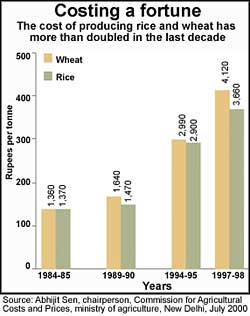
Punjab: end of the revolution ?
Cost of production has spiralled, but the rate of increase in production has not shown a similar trend. Ecological and social costs, meanwhile, are totally disregarded

Cost of production has spiralled, but the rate of increase in production has not shown a similar trend. Ecological and social costs, meanwhile, are totally disregarded
A professor of molecular biology and virology at the Salk Institute at La Jolla, USA, Dr Inder M Verma is also the chairperson of the Scientific Advisory Committee Overseas , Department of Biotechnology, Government of India. At the 16th International Con

A recent survey by the Union,ministry of surface transport has revealed the pitiable state of bridges in India
<font class='UCASE'>Jason Mark</font> and <font class='UCASE'>Candace Morey</font> , transportation analysts of UCS, have analysed various emission reduction technologies for diesel vehicles in their attempt to show that all of them have severe limitat

Residents of around 25 villages recently stopped the public hearing for a proposed methane extraction project. The 500-odd people from Gharghonda tehsil in Raigarh, armed with the Centre for

Scientists have developed a refrigerator that uses sound energy

Efforts are on to tackle the abysmal state of female health in India, especially among the poorer sections
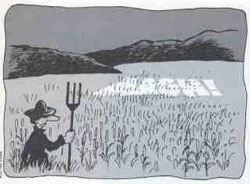
Transferred genes light up the prospects of keeping agricultural trouble makers in control
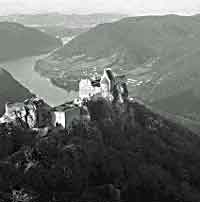
Dams prevent nutrients in rivers from reaching the oceans
Tobacco major Philip Morris unveils its new death policy
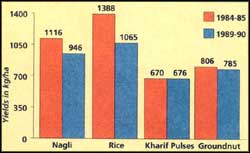
Alienation from traditional agricultural practices has ruined the economy of the Dangs
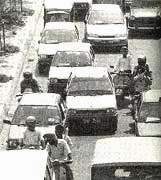
Remote sensing devices for measuring vehicular emissions have come of age
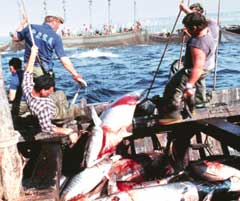
Fishery forecasts based on ocean colour can quadruple profits
Diesel is subsided to help the poor farmer run his pumpset. But this cheap fuel is used to drive expensive cars of the rich

A comprehensive study deplores that health care has become a marketable commodity

Green tea could prevent you from becoming liverish and weak hearted
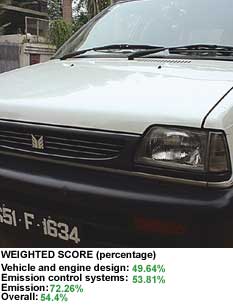
The oldest in the small car segment still holds fort. Maruti remains good value for money
One place in India where wild animals prosper
A few years ago, while delivering the Palkhivala Memorial Lecture in Mumbai on the then Finance Minister Jaswant Singh's Budget, P Chidambaram made the perceptive comment that it was the most unfunded budget in the country's history. There was no provision in the Annual Financial Statement on many new items of expenditure. Now, ironically, it is the turn of Yashwant Sinha to point out how Chidambaram's budget is silent on expenditure on such proposals as debt waiver! Any issue of bonds to banks by way of compensation for debt waiver and relief, especially when staggered over three years, will put them in the same predicament as the oil marketing companies burdened with similar IOUs. The bonds are not likely to qualify for investments to meet the Statutory Liquidity Ratio. In case of depreciation in their values, the banks will face the same problems they experienced a few years ago in adhering to prudential norms. The difficulties are cropping up at a time when the system is in transition to Basel-II norms. There is an ominous suggestion in some official quarters that banks that have already made provisions for the overdues of farm loans may not be given the compensation. It will be unfair to them. The overdue loans will still remain part of the gross non-performing assets of the institutions, reflecting on their soundness. The loan waiver does not solve the problem of farmer distress. The inequity in the definition of marginal or small farmers based only on cultivated holding is obvious. According to the budget document, a marginal farmer is one with a holding up to one hectare and a small farmer is one with holdings between one and two hectares. A farmer with, say, five hectares of rain-fed land in Pali Marwar in Rajasthan is economically in no better condition than one with two hectares with assured irrigation families in Ludhiana in the Punjab. But the former will not be eligible for the waiver. The need for adopting an income criterion for defining the size of farms was discussed in detail in the Reserve Bank of India's Report on the Seventh Follow-Up Rural Credit Survey entitled "The Small Farmers
<table border="0" cellpadding="0" cellspacing="0" width="210px"> <tbody> <tr> <td bgcolor="#363636" colspan="2" height="26px" style="color: rgb(255, 255, 255); font-size: 14px; padding-left:5px;"> Editor's Pick</td> </tr> </tbody> </table> <p><iframe frameborder="0" height="380" marginheight="0" marginwidth="0" scrolling="no" src="http://www.indiaenvironmentportal.org.in/files/country/nepal/nepal_iframe.htm" style="border-width:0px; border-color:#333; background:#FFF; border-style:solid;" width="555"></iframe></p> <hr /> <table border="0" cellpadding="0" cellspacing="0" width="210px"> <tbody> <tr> <td bgcolor="#363636" colspan="2" height="26px" style="color: rgb(255, 255, 255); font-size: 14px; padding-left:5px;"> Country Overview</td> </tr> </tbody> </table> <p><object align="right" height="248" hspace="1" vspace="1" width="330"><param name="quality" value="high" /><param name="wmode" value="opaque" /><param name="scale" value="showall" /><param name="flashvars" value="offsite=true&lang=en-us&page_show_url=%2Fphotos%2Fcsepictures%2Ftags%2Fnepal%2Fshow%2F&page_show_back_url=%2Fphotos%2Fcsepictures%2Ftags%2Fnepal%2F&user_id=40105063@N03&tags=nepal&jump_to=&start_index=" /><param name="movie" value="http://www.flickr.com/apps/slideshow/show.swf?v=121499" /><embed flashvars="offsite=true&lang=en-us&page_show_url=%2Fphotos%2Fcsepictures%2Ftags%2Fnepal%2Fshow%2F&page_show_back_url=%2Fphotos%2Fcsepictures%2Ftags%2Fnepal%2F&user_id=40105063@N03&tags=nepal&jump_to=&start_index=" height="248" hspace="1" quality="high" scale="showall" src="http://www.flickr.com/apps/slideshow/show.swf?v=121499" type="application/x-shockwave-flash" vspace="1" width="330" wmode="opaque"></embed></object></p> <p>Renowned for its majestic Himalayas, Nepal is rich in its geographic, natural, and cultural diversity. Nepal is divided into three broad geographic areas: the mountain region, the hill region, and the Terai region. Moving from east to west, the three regions lie parallel as continuous ecological belts, and are bisected by the country’s river system. Nepal is a relatively small country, measuring roughly 650 kilometers long by 200 kilometers wide, with a total land mass of 147,181 square kilometers. Situated between two Asian giants – China and India – Nepal has been characterized as a “yam caught between two rocks”. Since it is a landlocked country, Nepal is heavily dependent on India for transit facilities and access to the sea (Bay of Bengal) for delivery of its goods, even those coming from China.</p>